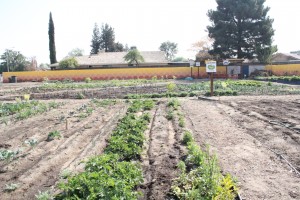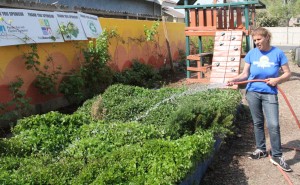By Alfredo Camacho / South Kern Sol
BAKERSFIELD, Calif. — The issue of availability of fresh local produce is somewhat resolved for the wealthier communities of Kern County, such as those of Haggin Oaks, who enjoy a weekly farmer’s market. But for Latino communities in South Kern, many of whom are the very farmers who produce the wealth that makes this region famous for its agriculture, access to fresh local produce is largely nonexistent.
One ray of hope for South Kern is the continuing growth of the Greenfield Community Garden.
“Do you smell that?” asked Gema Perez as she watered some herbs with a hose. The impact of the water shook loose waves of aromas from basil, peppermint, and parsley. “I personally tend to it, but this is for everyone to share if they want some.”
The Greenfield Community Garden, which takes up a corner lot in the community of Greenfield, is a project spearheaded by the Greenfield Walking Group and sponsored in part by local businesses and politicians. Members of the community tend to the garden themselves, growing a wide array of fruits and vegetables.
The system they’ve developed is simple: participants are assigned a plot in which they grow whatever they please and they maintain their own plot. Failure to do so results in the seizure of the plot and is given to the next person on the waiting list.
 “Each of us has a little plot and we maintain our own area, sowing, watering, weeding, harvesting,” said Sara Palominos. “Right now, I have onions, tomatoes, tomatillos, radishes, cilantro, and I just sowed asparagus.”
“Each of us has a little plot and we maintain our own area, sowing, watering, weeding, harvesting,” said Sara Palominos. “Right now, I have onions, tomatoes, tomatillos, radishes, cilantro, and I just sowed asparagus.”
With many people sowing different produce, gardeners can complement each others’ harvests. Erika Diaz explains the basics of produce swapping.
“We exchange produce,” said Diaz. “We might even ask permission of one of the other people if we can just pick what we need ourselves, and so long as we respect each other and ask for permission, we can get way more fresh produce.”
Since South Kern Sol’s last article about the garden in September, the garden has grown even more, both in actual produce, and in the social network of the community.
“We began with just a few people planting and tending to it,” recounted Perez. “Now there’s a waiting list for people to get their own plots.”
All counted, the people involved and their families make up a network of almost 100 people who benefit from the garden.
One outgrowth of the garden is a shared sense of community among the participants. Along with the sharing of a space for growing produce, cooperation to ensure crop diversity, and complementing each others’ harvests through exchange and gifts, the shared space also hosts a weekly Monday barbecue for participants to come together. Back at the garden, Perez gives a tour of the amenities.
“This area is where we have carne asadas and meetings,” said Perez, motioning to a corner of the lot with her hose. The area has a few benches, a barbeque, a veranda, and is adorned with signs thanking sponsors for helping with the garden. “This garden has worked wonders for our community, beautifying it and teaching our families about the value of quality food.”
Diaz, who is currently harvesting carrots and growing strawberries, describes how her children help tend to the garden, and learn about where food comes from.
“My son gets so excited when he starts to see a carrot starting to emerge,” said Diaz. “He’ll say, ‘Mommy, mommy look!’ and try to pull it out, but I have to tell him to wait.”
Harvesting quality produce is a lesson that the garden is teaching everyone in the family.
“I’ve noticed a huge difference in quality between what we grow in the garden and what I get in the store,” said Grisette Lopez. “At stores you look for quality, but when you get tomatoes on sale, if you don’t use them that day, they spoil.”
“It’s a learning experience for all of us,” Diaz said.
